SureFire SOCOM-4 Series—A New Fighting Suppressor
Fountain Valley, CA—SureFire, LLC, manufacturer of the world’s finest—and most innovative—illumination tools and…
Fountain Valley, CA—SureFire, LLC, manufacturer of the world’s finest—and most innovative—illumination tools and…
Shinenyx—creators of a cutting-edge fusion of digital night vision and thermal imaging technology—has…
German Precision Optics’ Passion APO is a high-performance compact spotting scope designed and…
The Mod-Navy Qual I’ve been doing this qual (or drill, or whatever the current nom…
• Built for road trips and off-road use• Manual transmission equipped• Wrapped in MultiCam Arctic…
I designed the Button Man to give shooters a low-round-count, low-light-engagement drill that involved both…
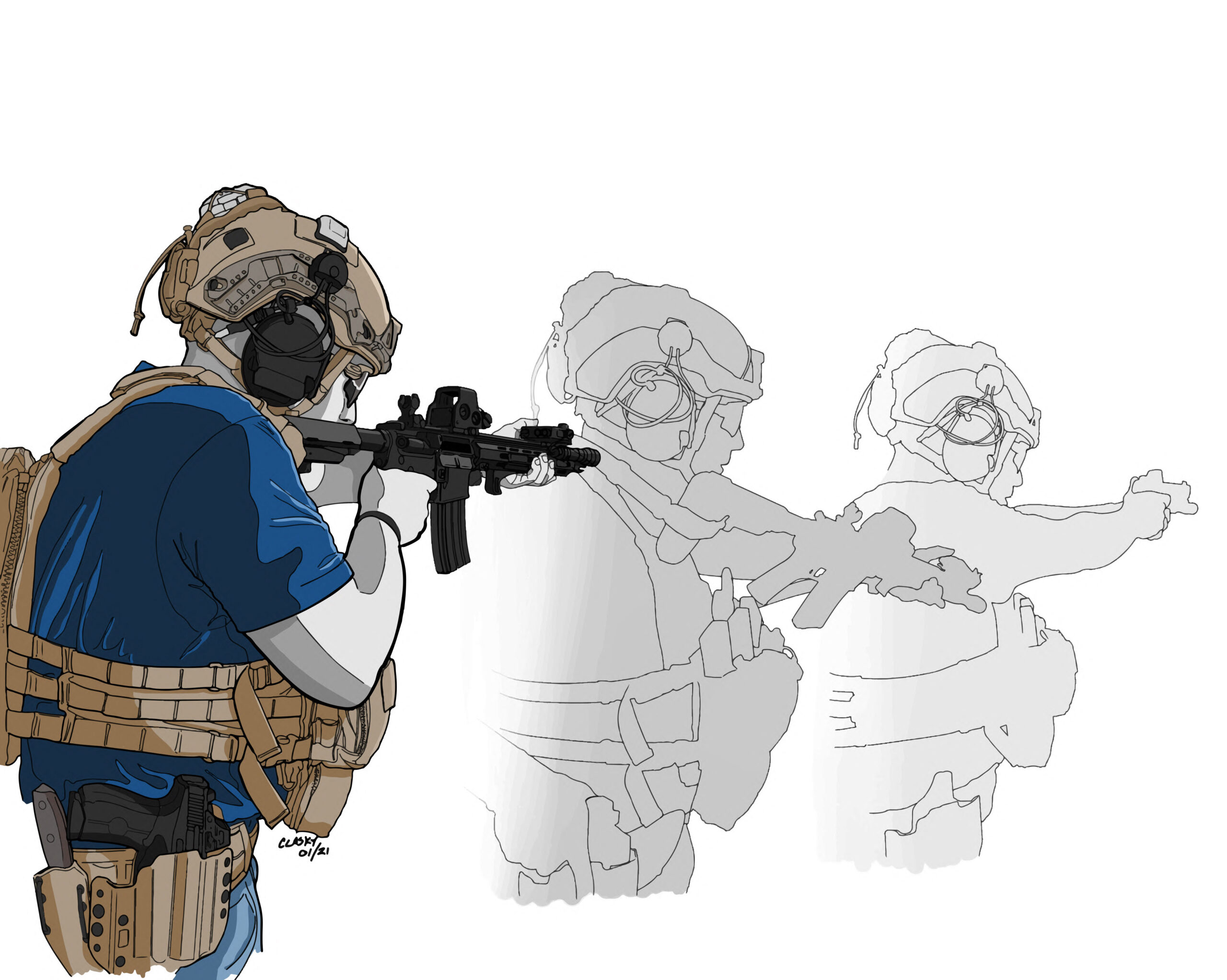
Most shooting exercises serve a specific purpose. Exercises like transition drills involve a common skill practiced by most dedicated students of firearms. A transition occurs for two reasons—because you “have to” or because you “want to.”
The situation where you “have to” occurs when your primary weapons fails for whatever reason and you still have a relatively close and imminent threat. It is generally faster to go to another platform that you know is working than trying to fix an unknown stoppage. A situation where you would “want to” transition is related to confined spaces where the longer system not easily maneuvered or practical.
Proper execution of nearly any weapon-related training is measured in two ways: time and accuracy. To truly improve at something a standard must be set, and honest evaluation of your efficiency must be performed. That can be accomplished through training with a competent instructor, proper dry practice, and further accomplished by reviewing video of yourself executing an exercise.
“This above all to thine own self be true.” Translation—remove your ego and identify what you can improve on. Repeated proper execution results in efficiency. Repeated poor execution translates to very inefficient movement that will never realize its true potential. You may appear to move quickly, but poor execution will always drain your abilities.
In executing a known-outcome drill, you are moving at the optimum speed in execution. An example: You have one round in the rifle with an empty magazine inserted. There is no delay in reaction because it’s a choreographed motion. You know it’s coming; it’s rehearsed. Most importantly, you look wicked-quick for Instagram… ninja! The shooter is aware that the primary weapon will fail (bolt lock, a dummy round in a known location, and the like). An exercise like this is useful in how to do something. But it is important to progress further and learn when to do something. Not as ninja, but incredibly important. Hence an unknown-outcome drill.
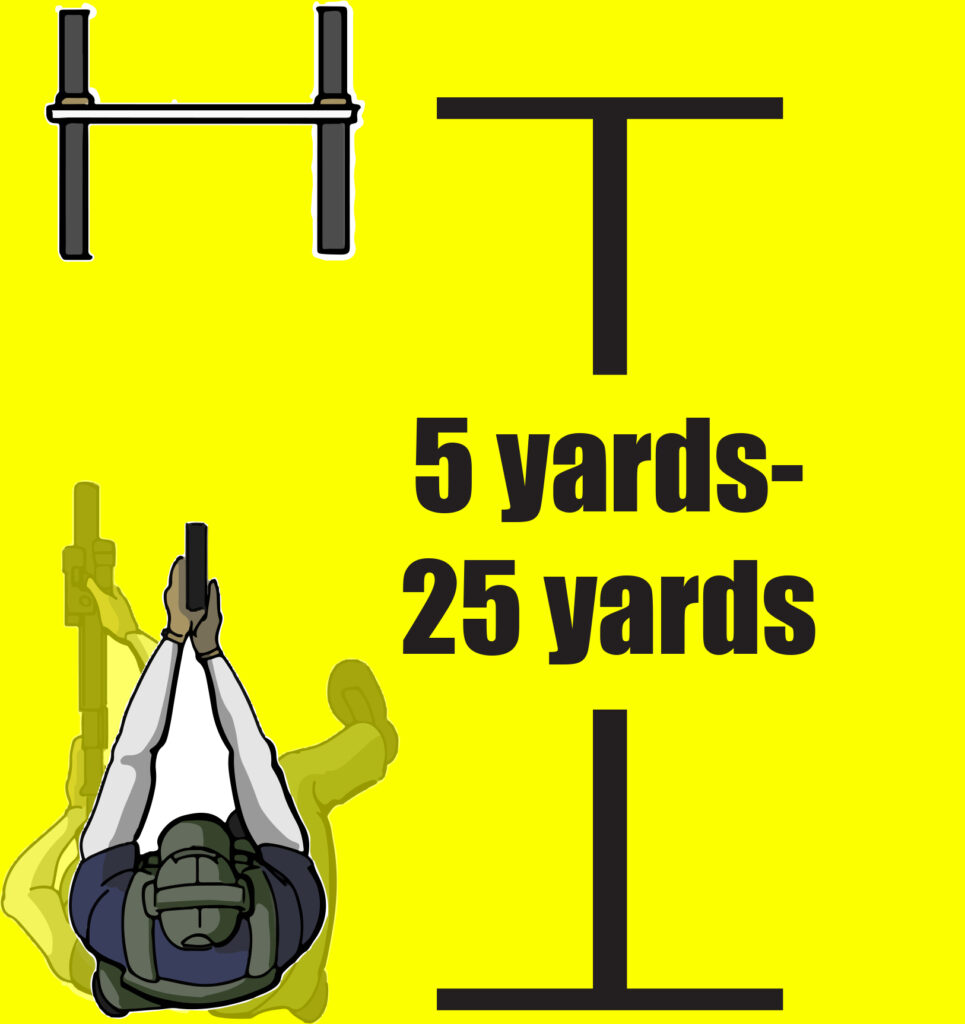
An unknown-outcome drill works on the principle of creating or developing a reaction based on a stimulus. It is a method of developing unconscious competence when certain circumstances arrive, like a bolt lock on the last round fired. That is one of the most common reasons a weapon stops working, so it creates a good baseline. As you get more reps and your reaction time is reduced, a different stimulus can be introduced like inserting dummy rounds into the magazine to simulate a failure to fire. It is important to recreate and assess all the possibilities to train a proper reaction—the infamous if/then circumstance used in martial arts, wrestling, MMA, fighting in general.
For now, we’ll work around the bolt-lock/last-round scenario. Here is what you will need:
• Rifle with sling
• 5 rifle magazines loaded with 2 to 4 rounds each; mix it up as much as you can.
• Pistol with at least 2 full magazines
• 1 B8 NRA target
• Pro-timer
• A minimum 25-yard range
The Setup
You should have a loaded pistol in the holster (retention activated if the holster is so-equipped) and at least one spare pistol magazine in a pouch. Grab one of your five randomly loaded magazines and load it into the rifle. Shuffle the other rifle magazines and load them randomly into the rest of your rifle pouches. Part of the exercise is getting your long gun back into service and you should reload from whatever pouches you have on your kit. Empty magazines will remain on the ground at the end of the drill. This forces the shooter to utilize all his gear, not just the pouch he speed-reloads from all the time.
If you are not wearing full kit or a chest rig, have at least one pouch that you would normally reload from. Upon completing the drill at each specific distance, randomly grab another partially loaded rifle magazine and refill that pouch in preparation for the next evolution. This is a five-part scored exercise.
Objective
The exercise objectives are quite simple—deliver five accurate rounds inside the 8 ring of the B8 target at five different distances under a prescribed time. At each distance, half a second is added to the time. Somewhere during the engagement sequence the weapon will go to bolt lock and the shooter will have to make up shots with the pistol to achieve five hits. At each distance the shooter will start, safety on, at the low ready position with the rifle. The sequence for the drill is as follows:
• 5 yards—5 rounds in 5 sec.
• 10 yards—5 rounds in 5.5 sec.
• 15 yards—5 rounds in 6 sec.
• 20 yards—5 rounds in 6.5 sec.
• 25 yards—5 rounds in 7 sec.
Don’t Stop When You Are Done Shooting
After each sequence, don’t just stop and set up for the next distance; make a training evolution whenever possible. In this case, while the pistol is still out of the holster, check the condition of your rifle. Holster the pistol and execute an efficient speed reload on the rifle so you end the way you started—ready to fight. This should be done as smoothly and as expediently as possible. Draw from the next available rifle pouch as you go. Again, leave the empty mags on the ground and work all the pouches on your equipment.
Based on the number of rounds fired, you may elect to tac-load the pistol before putting it away or before topping off the rifle. Whenever you can stop and think, always try to improve your situation. There should be a trail of rifle magazines leading to the target when you are finished. The time allotment seems generous, and it is. But three things increase time.
Stress is created in two ways: There is limited time and you do not exactly know when the weapon will fail. You must figure it out.
When you add up those factors and the fact that the magazine you have in your rifle may be the one with only two rounds, suddenly the time becomes tight. You may shoot the four-round magazine at 25 yards and have to fire only one pistol round. The time is no issue. Or in my case, I always seem to get the two-round magazine at 25 yards and have to deliver three rounds with a pistol at the 8 ring. Time is suddenly an issue.
The target is scored two different ways. Everything inside the 8 ring is one point, so there is a potential total of 25 points. You can also score it as the B8 is meant to be scored: 10, 9, 8, with a total potential score of 250. If there is a tie for shots inside the 8 ring, score it as a 250 drill to determine the winner. Accuracy counts.
Moving The Bar
You will quickly discover if the drill is a little too advanced or perhaps too easy based on your performance. Becoming frustrated guarantees that the exercise with be discarded, regardless of its benefit. So reset the time to be longer until a majority of your rounds (22 or 23 out of 25) start landing in the 8 ring or better. After meeting the goal, start dialing the time back again.
The prescribed times are achievable in a variety of shooting conditions (gear, concealed, heavy clothing in the cold, in the rain, whatever). Once you refine all the mechanics, analyze where you are bleeding out efficiency, revisit the drill and the times. Work on those elements in dry practice. Isolate the inefficiency, then try it again live.
Are you crushing it at the current times? Dial it back further until you begin to reach failure, then start again. Eventually you will plateau. The strongest shooters will find where their draw time really is. How quickly they can achieve a load. How fast they can transition targets. They cannot typically achieve any more speed or accuracy consistently past a certain point. Consistency is the key word.
Efficiency Counts
Some of the keys to success for a drill like this are all about efficiency. Efficiency comes from two primary areas: marksmanship/recoil management and weapon manipulations. Time is lost for multiple reasons. Maybe there’s a longer delay in recognizing bolt lock, forcing you to tune in more with the weapon. Perhaps the presentation of the rifle is too slow or inefficient. What should be a 0.6 or 0.75 shot at 5 yards is 1 to 1.2 seconds to the first shot. Or perhaps the transition time itself is taking 4 seconds when it could be brought down to under 3.
The presentation of and the transition to the pistol should be just as fast at five yards as they are at 25 yards. If you looked independently at the efficiency and time of getting the sights onto the target at all distances, they should look about the same. What changes is the set time/trigger management of the weapons at those distances.
From a marksmanship standpoint, delivering rounds with a rifle at distance is faster because of the four points of contact to the weapon and the recoil management a larger weapon affords. The pistol requires more finesse as the distance increases. Delivering accurate rounds at distance with a 2-pound pistol with a 5- to 7-pound trigger while controlling recoil with two points of contact changes how quickly the trigger can be managed.
Two different weapons translate to different trigger-management techniques to achieve similar accuracy. Trading one weapon for another means tapping into similar but different skill sets. You may be strong in the ways of the pistol but really need to work on the rifle. Normally it’s the other way around. But this drill will expose cracks in your training regimen. You may be losing time on the transition itself. And then there’s overall accuracy with both weapons. Discerning rifle rounds from pistol rounds is easy when it’s a 5.56 versus a 9mm or .45. You’ll quickly recognize which is doing better.
After you master how to do something, you must master when to do it. This exercise will force all of those elements to flow together and create a reaction, rather than what amounts to a choreographed dance that makes you look good on Instagram.
About the Author
ost shooting exercises serve a specific purpose. Exercises like transition drills involve a common skill practiced by most dedicated students of firearms. A transition occurs for two reasons—because you “have to” or because you “want to.”
The situation where you “have to” occurs when your primary weapons fails for whatever reason and you still have a relatively close and imminent threat. It is generally faster to go to another platform that you know is working than trying to fix an unknown stoppage. A situation where you would “want to” transition is related to confined spaces where the longer system not easily maneuvered or practical.
Proper execution of nearly any weapon-related training is measured in two ways: time and accuracy. To truly improve at something a standard must be set, and honest evaluation of your efficiency must be performed. That can be accomplished through training with a competent instructor, proper dry practice, and further accomplished by reviewing video of yourself executing an exercise.
“This above all to thine own self be true.” Translation—remove your ego and identify what you can improve on. Repeated proper execution results in efficiency. Repeated poor execution translates to very inefficient movement that will never realize its true potential. You may appear to move quickly, but poor execution will always drain your abilities.
In executing a known-outcome drill, you are moving at the optimum speed in execution. An example: You have one round in the rifle with an empty magazine inserted. There is no delay in reaction because it’s a choreographed motion. You know it’s coming; it’s rehearsed. Most importantly, you look wicked-quick for Instagram… ninja! The shooter is aware that the primary weapon will fail (bolt lock, a dummy round in a known location, and the like). An exercise like this is useful in how to do something. But it is important to progress further and learn when to do something. Not as ninja, but incredibly important. Hence an unknown-outcome drill.
An unknown-outcome drill works on the principle of creating or developing a reaction based on a stimulus. It is a method of developing unconscious competence when certain circumstances arrive, like a bolt lock on the last round fired. That is one of the most common reasons a weapon stops working, so it creates a good baseline. As you get more reps and your reaction time is reduced, a different stimulus can be introduced like inserting dummy rounds into the magazine to simulate a failure to fire. It is important to recreate and assess all the possibilities to train a proper reaction—the infamous if/then circumstance used in martial arts, wrestling, MMA, fighting in general.
For now, we’ll work around the bolt-lock/last-round scenario. Here is what you will need:
• Rifle with sling
• 5 rifle magazines loaded with 2 to 4 rounds each; mix it up as much as you can.
• Pistol with at least 2 full magazines
• 1 B8 NRA target
• Pro-timer
• A minimum 25-yard range
The Setup
You should have a loaded pistol in the holster (retention activated if the holster is so-equipped) and at least one spare pistol magazine in a pouch. Grab one of your five randomly loaded magazines and load it into the rifle. Shuffle the other rifle magazines and load them randomly into the rest of your rifle pouches. Part of the exercise is getting your long gun back into service and you should reload from whatever pouches you have on your kit. Empty magazines will remain on the ground at the end of the drill. This forces the shooter to utilize all his gear, not just the pouch he speed-reloads from all the time.
If you are not wearing full kit or a chest rig, have at least one pouch that you would normally reload from. Upon completing the drill at each specific distance, randomly grab another partially loaded rifle magazine and refill that pouch in preparation for the next evolution. This is a five-part scored exercise.
Objective
The exercise objectives are quite simple—deliver five accurate rounds inside the 8 ring of the B8 target at five different distances under a prescribed time. At each distance, half a second is added to the time. Somewhere during the engagement sequence the weapon will go to bolt lock and the shooter will have to make up shots with the pistol to achieve five hits. At each distance the shooter will start, safety on, at the low ready position with the rifle. The sequence for the drill is as follows:
• 5 yards—5 rounds in 5 sec.
• 10 yards—5 rounds in 5.5 sec.
• 15 yards—5 rounds in 6 sec.
• 20 yards—5 rounds in 6.5 sec.
• 25 yards—5 rounds in 7 sec.
Don’t Stop When You Are Done Shooting
After each sequence, don’t just stop and set up for the next distance; make a training evolution whenever possible. In this case, while the pistol is still out of the holster, check the condition of your rifle. Holster the pistol and execute an efficient speed reload on the rifle so you end the way you started—ready to fight. This should be done as smoothly and as expediently as possible. Draw from the next available rifle pouch as you go. Again, leave the empty mags on the ground and work all the pouches on your equipment.
Based on the number of rounds fired, you may elect to tac-load the pistol before putting it away or before topping off the rifle. Whenever you can stop and think, always try to improve your situation. There should be a trail of rifle magazines leading to the target when you are finished. The time allotment seems generous, and it is. But three things increase time.
Stress is created in two ways: There is limited time and you do not exactly know when the weapon will fail. You must figure it out.
When you add up those factors and the fact that the magazine you have in your rifle may be the one with only two rounds, suddenly the time becomes tight. You may shoot the four-round magazine at 25 yards and have to fire only one pistol round. The time is no issue. Or in my case, I always seem to get the two-round magazine at 25 yards and have to deliver three rounds with a pistol at the 8 ring. Time is suddenly an issue.
The target is scored two different ways. Everything inside the 8 ring is one point, so there is a potential total of 25 points. You can also score it as the B8 is meant to be scored: 10, 9, 8, with a total potential score of 250. If there is a tie for shots inside the 8 ring, score it as a 250 drill to determine the winner. Accuracy counts.
Moving The Bar
You will quickly discover if the drill is a little too advanced or perhaps too easy based on your performance. Becoming frustrated guarantees that the exercise with be discarded, regardless of its benefit. So reset the time to be longer until a majority of your rounds (22 or 23 out of 25) start landing in the 8 ring or better. After meeting the goal, start dialing the time back again.
The prescribed times are achievable in a variety of shooting conditions (gear, concealed, heavy clothing in the cold, in the rain, whatever). Once you refine all the mechanics, analyze where you are bleeding out efficiency, revisit the drill and the times. Work on those elements in dry practice. Isolate the inefficiency, then try it again live.
Are you crushing it at the current times? Dial it back further until you begin to reach failure, then start again. Eventually you will plateau. The strongest shooters will find where their draw time really is. How quickly they can achieve a load. How fast they can transition targets. They cannot typically achieve any more speed or accuracy consistently past a certain point. Consistency is the key word.
Efficiency Counts
Some of the keys to success for a drill like this are all about efficiency. Efficiency comes from two primary areas: marksmanship/recoil management and weapon manipulations. Time is lost for multiple reasons. Maybe there’s a longer delay in recognizing bolt lock, forcing you to tune in more with the weapon. Perhaps the presentation of the rifle is too slow or inefficient. What should be a 0.6 or 0.75 shot at 5 yards is 1 to 1.2 seconds to the first shot. Or perhaps the transition time itself is taking 4 seconds when it could be brought down to under 3.
The presentation of and the transition to the pistol should be just as fast at five yards as they are at 25 yards. If you looked independently at the efficiency and time of getting the sights onto the target at all distances, they should look about the same. What changes is the set time/trigger management of the weapons at those distances.
From a marksmanship standpoint, delivering rounds with a rifle at distance is faster because of the four points of contact to the weapon and the recoil management a larger weapon affords. The pistol requires more finesse as the distance increases. Delivering accurate rounds at distance with a 2-pound pistol with a 5- to 7-pound trigger while controlling recoil with two points of contact changes how quickly the trigger can be managed.
Two different weapons translate to different trigger-management techniques to achieve similar accuracy. Trading one weapon for another means tapping into similar but different skill sets. You may be strong in the ways of the pistol but really need to work on the rifle. Normally it’s the other way around. But this drill will expose cracks in your training regimen. You may be losing time on the transition itself. And then there’s overall accuracy with both weapons. Discerning rifle rounds from pistol rounds is easy when it’s a 5.56 versus a 9mm or .45. You’ll quickly recognize which is doing better.
After you master how to do something, you must master when to do it. This exercise will force all of those elements to flow together and create a reaction, rather than what amounts to a choreographed dance that makes you look good on Instagram.
Text by Thomas Alibrando and illustrations by Charles “Chip” Lasky
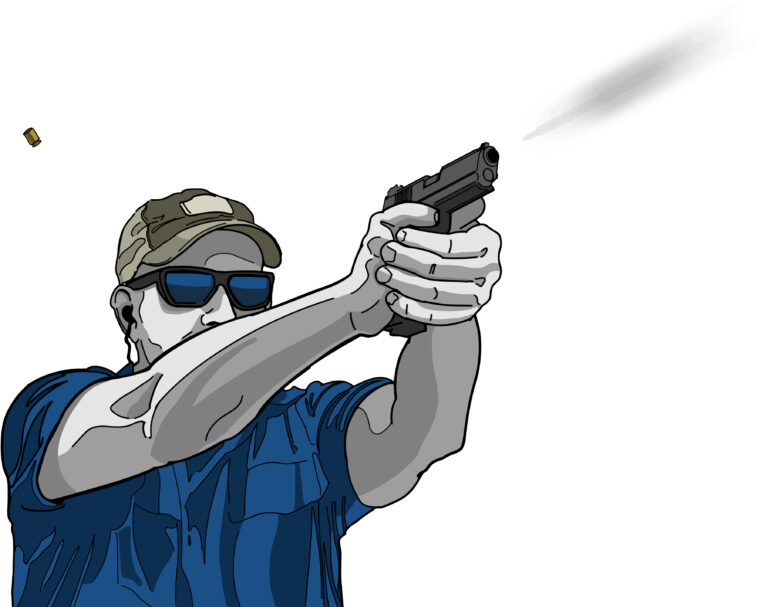
Static-position shooting is great for practicing marksmanship and its fundamentals, but those who are in the professional field understand that practicing single-position shooting is just the beginning. Shooter…
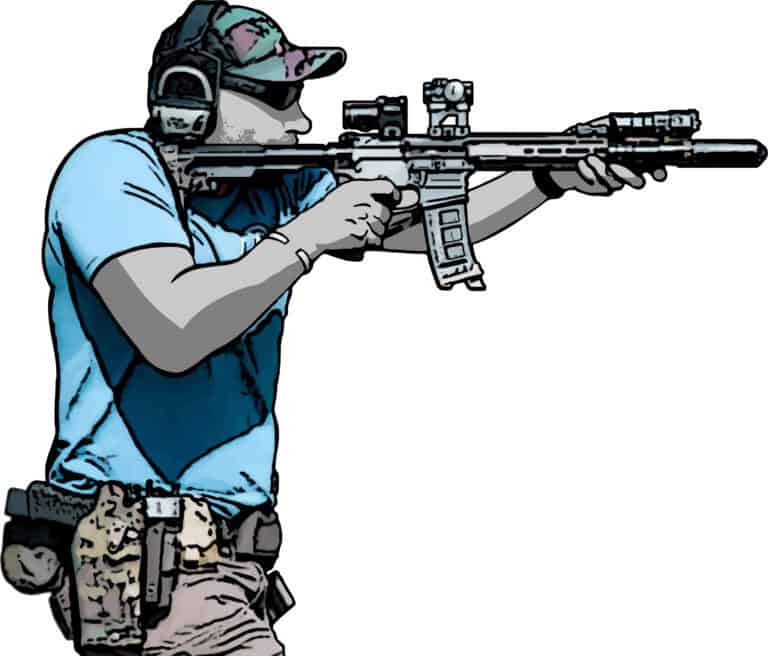
The V Exercise was created for those who would like a continuous moving-and-shooting exercise that can be scaled to a moving-and-transitioning exercise. It is intended to force more…
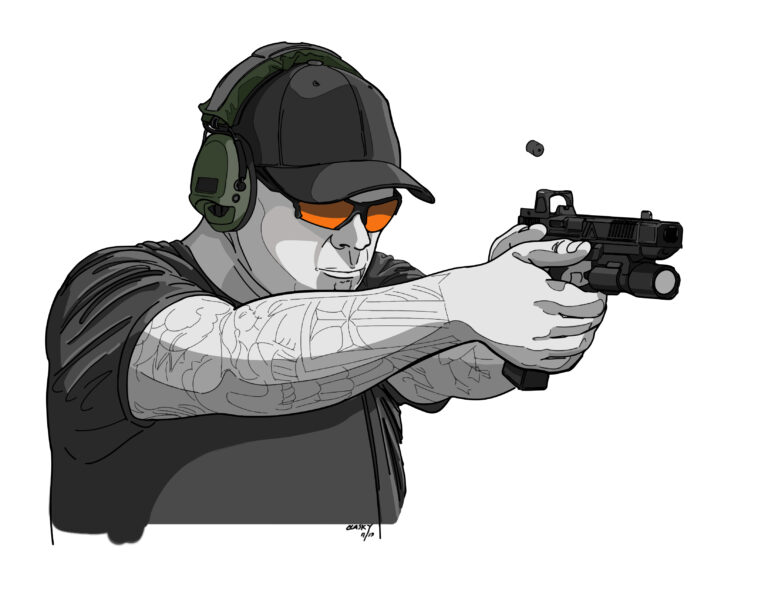
Shooting drills are an important part of formal training and an important part of practice. Whether for self-defense or competition, a drill establishes a goal, and goals are…
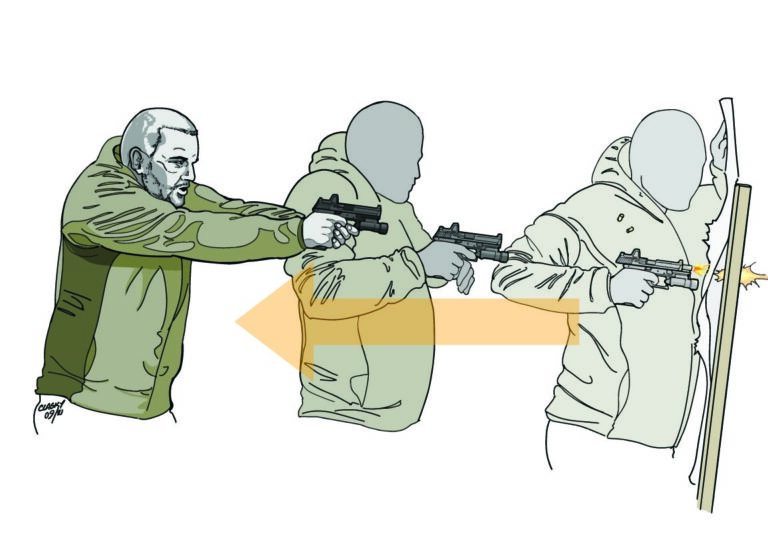
The skill of firing accurate rounds into a threat from retention is an underappreciated and under-practiced skill. Shooting from retention at close ranges can help ensure a threat…
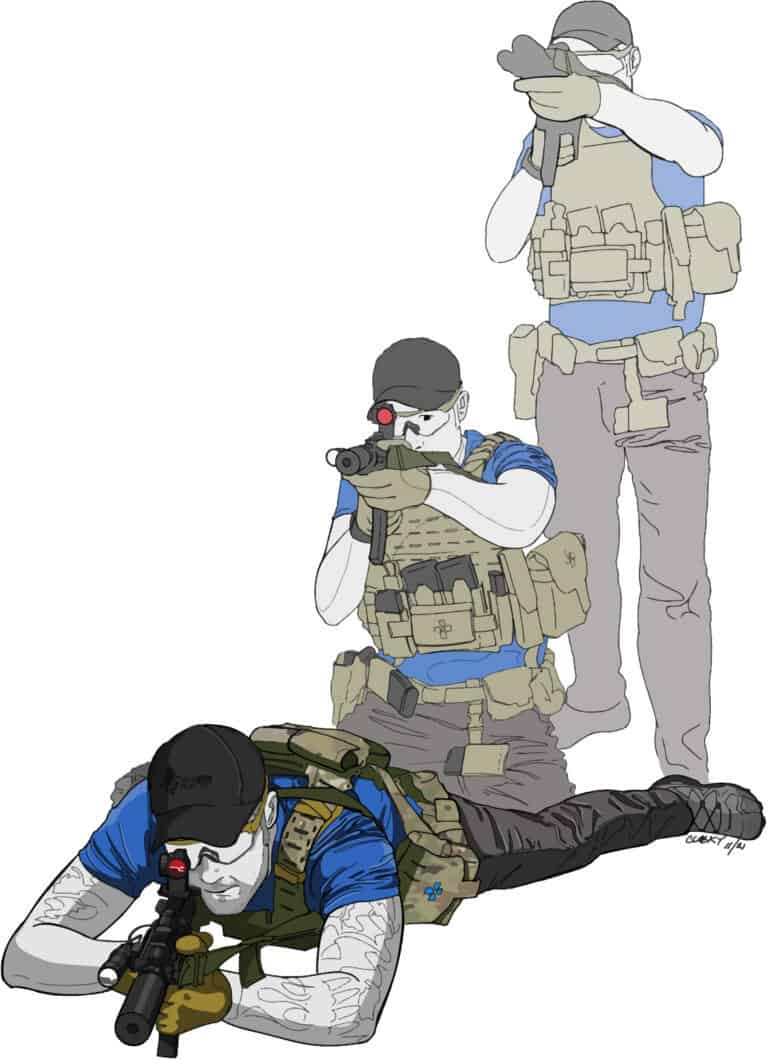
The Mod-Navy Qual I’ve been doing this qual (or drill, or whatever the current nom de guerre is for graded shooting), or some variation of it for almost…
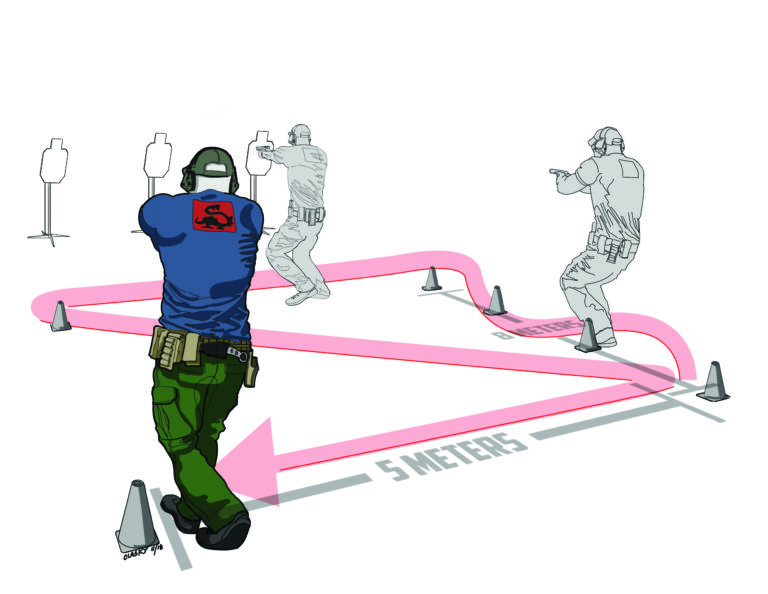
In the teachings of the Martial Arts, there must be a close synchronization between closing and opening distance and the various actions of the hands and feet. The…
© 2025 UN12 Magazine
© 2025 UN12 Magazine
Wait! Don’t forget to